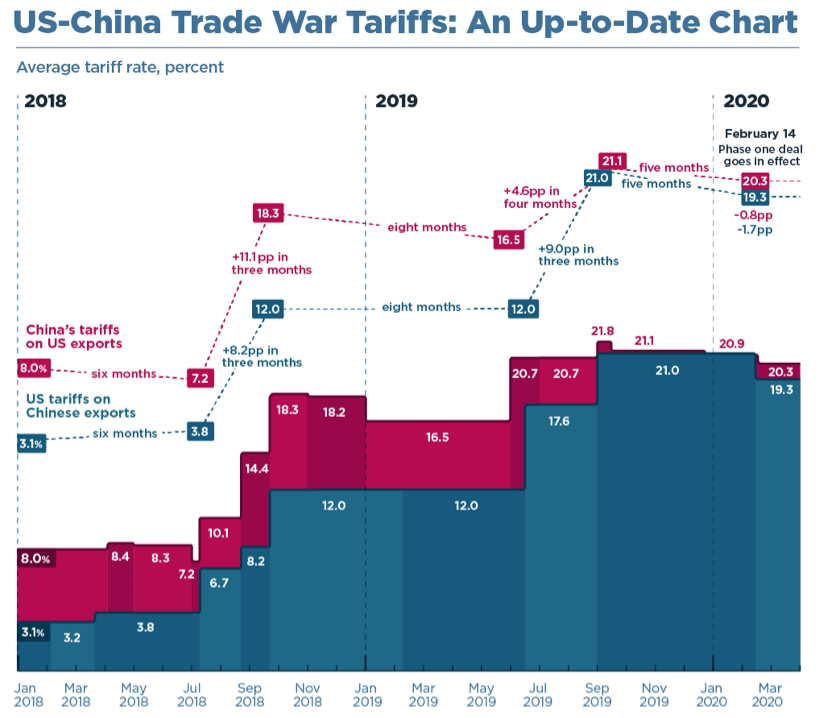Impact Of Extended 30% Tariffs On US-China Trade Relations

Table of Contents
The US-China trade war, marked by significant tariff increases, has profoundly reshaped global commerce. The imposition and extension of 30% tariffs on numerous goods exchanged between the two economic giants represent a pivotal moment in this ongoing conflict. This article delves into the multifaceted impact of these tariffs, examining their economic consequences, geopolitical implications, and potential solutions. We will analyze how these tariffs affect businesses, consumers, and the broader global trade landscape, exploring the long-term effects on US-China trade relations and the global economy.
Economic Consequences of the 30% Tariffs
The 30% tariffs imposed on goods traded between the US and China have triggered a ripple effect across various sectors, significantly impacting businesses and consumers on both sides of the Pacific.
Impact on US Businesses
The increased costs associated with imported goods from China have placed a considerable strain on many US businesses.
- Increased costs for imported goods: Businesses relying on Chinese imports for raw materials or finished products face higher production costs, impacting profitability and competitiveness.
- Reduced competitiveness of US businesses: The increased cost of goods makes US businesses less competitive in both domestic and international markets.
- Potential job losses in affected industries: Some businesses, unable to absorb the increased costs, may be forced to downsize or even close, leading to job losses in affected industries like manufacturing and agriculture.
- Shifting of supply chains away from China: Many companies are actively seeking alternative suppliers outside of China to mitigate the impact of the tariffs, leading to a restructuring of global supply chains.
Specific industries affected:
- Manufacturing (electronics, textiles, furniture)
- Agriculture (soybeans, pork)
- Technology (semiconductors, electronics components)
Impact on Chinese Businesses
Chinese businesses exporting to the US have experienced a significant downturn due to the tariffs.
- Decreased export revenue: Reduced demand from US consumers and businesses has directly decreased export revenues for Chinese companies.
- Reduced demand for Chinese goods: The tariffs have made Chinese goods less attractive in the US market, forcing some businesses to lower prices or reduce production.
- Potential job losses in export-oriented industries: Companies reliant on US exports have faced job losses as demand shrinks.
- Retaliatory tariffs impacting US exports to China: China has implemented retaliatory tariffs on US goods, creating a reciprocal negative impact on US businesses.
Specific sectors affected:
- Technology (telecommunications equipment, computer components)
- Textiles and apparel
- Manufacturing (machinery, automotive parts)
Impact on Consumers
Ultimately, the burden of these tariffs is often shouldered by consumers.
- Higher prices for consumer goods: Increased import costs are passed on to consumers in the form of higher prices for a wide range of goods.
- Reduced consumer purchasing power: Higher prices for essential goods reduce consumer purchasing power, impacting overall economic activity.
- Limited product choices: Some goods may become unavailable or significantly more expensive, limiting consumer choice.
- Inflationary pressures: The increased cost of goods contributes to inflationary pressures, further eroding consumer purchasing power.
Examples of affected consumer goods:
- Electronics
- Clothing and footwear
- Household appliances
Geopolitical Implications of the Trade Dispute
Beyond the economic consequences, the 30% tariffs have severely strained US-China relations and destabilized the global trade order.
Strained US-China Relations
The trade war has significantly increased political tension and mistrust between the US and China.
- Increased political tension and mistrust: The imposition of tariffs has exacerbated existing geopolitical tensions, creating a climate of distrust and animosity.
- Impact on diplomatic relations and international collaborations: The trade dispute has complicated diplomatic relations and hindered cooperation on other global issues.
- Potential for escalation of the trade war: The ongoing conflict carries the risk of further escalation, with the potential for more extensive tariffs or other trade restrictions.
- Broader implications for global governance: The trade war raises concerns about the future of multilateral trade agreements and the stability of the global economic system.
Specific political events and statements: The ongoing dialogue (or lack thereof) between the US and China regarding trade, statements from government officials, and retaliatory actions, all contribute to the strained relationship.
Impact on Global Trade
The US-China trade dispute has created significant uncertainty and disruption in global markets.
- Uncertainty in global markets: The ongoing trade war creates uncertainty for businesses worldwide, hindering investment and economic growth.
- Disruption of global supply chains: The shifting of supply chains away from China disrupts established global trade networks.
- Potential for trade diversion to other countries: Countries outside the US and China may benefit from the trade diversion, while others could face negative consequences.
- Impact on multilateral trade organizations (e.g., WTO): The trade war challenges the authority and effectiveness of multilateral trade organizations.
Effects on specific global trade routes and agreements: The impact is felt across various trade agreements and routes, affecting global supply chains and economic stability.
Potential Solutions and Future Outlook
Addressing the negative impacts of the 30% tariffs requires a multifaceted approach that involves both negotiation and strategic adjustments by businesses.
Negotiation and Trade Agreements
A negotiated settlement remains a crucial step towards resolving the trade dispute and mitigating the negative effects.
- Potential for future trade negotiations: Renewed dialogue and negotiations between the US and China are essential to reach a mutually beneficial agreement.
- Possible compromises and concessions: Both sides may need to make compromises and concessions to reach a lasting agreement.
- Alternative trade agreements: Exploring alternative trade agreements or frameworks could provide a path forward.
Potential solutions and their feasibility: Negotiating a comprehensive trade agreement that addresses the concerns of both sides, while being mindful of global economic stability, is crucial.
Diversification of Supply Chains
Reducing reliance on China for imports is a key strategic goal for many US businesses.
- Strategies for reducing reliance on Chinese imports: Businesses can explore alternative sourcing options, including reshoring and nearshoring.
- Benefits and challenges of reshoring and nearshoring: Reshoring (returning production to the US) and nearshoring (moving production to nearby countries) offer potential benefits but also present challenges related to cost and logistics.
- Role of technology and automation: Technology and automation can play a significant role in improving efficiency and reducing reliance on imports.
Specific actions businesses can take: Conduct thorough supply chain audits, explore alternative suppliers, invest in automation and technology, and reassess their risk tolerance.
Conclusion
The extended 30% tariffs on US-China trade have had profound and far-reaching economic and geopolitical consequences. The impact on businesses, consumers, and global trade has been significant, characterized by increased costs, reduced competitiveness, and heightened uncertainty. The strained relationship between the US and China highlights the need for a negotiated solution and a strategic adjustment of supply chains. Staying informed about developments in US-China trade relations is crucial for businesses and individuals alike. To stay updated on the ongoing impact of these tariffs and future developments in US-China trade relations, subscribe to our newsletter for expert analysis and insights. Understanding the complexities of the 30% tariffs on US-China trade relations requires continuous monitoring and engagement.

Featured Posts
-
 The American Manhunt For Osama Bin Laden A Documentary Review
May 18, 2025
The American Manhunt For Osama Bin Laden A Documentary Review
May 18, 2025 -
 Soriano Shines As Angels Defeat White Sox In Low Scoring Matchup
May 18, 2025
Soriano Shines As Angels Defeat White Sox In Low Scoring Matchup
May 18, 2025 -
 Pet Shop Boys Fka Twigs Jorja Smith And Father John Misty To Headline Meo Kalorama 2025 Music Festival
May 18, 2025
Pet Shop Boys Fka Twigs Jorja Smith And Father John Misty To Headline Meo Kalorama 2025 Music Festival
May 18, 2025 -
 1 Op 6 Nederlanders Negeert Dreigend Vuurwerkverbod
May 18, 2025
1 Op 6 Nederlanders Negeert Dreigend Vuurwerkverbod
May 18, 2025 -
 Reddits New Policy Cracking Down On Violent Content Upvotes
May 18, 2025
Reddits New Policy Cracking Down On Violent Content Upvotes
May 18, 2025
Latest Posts
-
 Amanda Bynes Seen With Friend After Only Fans Launch
May 18, 2025
Amanda Bynes Seen With Friend After Only Fans Launch
May 18, 2025 -
 Amanda Bynes Steps Out New Only Fans Content Revealed
May 18, 2025
Amanda Bynes Steps Out New Only Fans Content Revealed
May 18, 2025 -
 Amanda Bynes Post Only Fans Public Appearance
May 18, 2025
Amanda Bynes Post Only Fans Public Appearance
May 18, 2025 -
 Amanda Bynes Only Fans A Look At Her Recent Public Appearance
May 18, 2025
Amanda Bynes Only Fans A Look At Her Recent Public Appearance
May 18, 2025 -
 Amanda Bynes Spotted After Joining Only Fans
May 18, 2025
Amanda Bynes Spotted After Joining Only Fans
May 18, 2025
